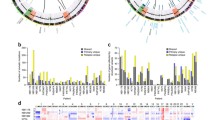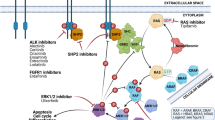Abstract
Aberrant RAS/RAF signaling has been reported to be important for many tumor types including gliomas. Activation of the RAS/RAF pathway can result from oncogenic mutations of RAS/RAF itself. However, such mutations have only occasionally been reported in gliomas. In order to further elucidate the role of RAS/RAF pathway activation in a histopathological and genetic spectrum of glioma subtypes (n = 93), we evaluated different types of aberrations in this pathway. Hotspot mutation analysis of BRAF, NRAS, KRAS, and HRAS revealed only two mutations, V600M in BRAF and G10E in NRAS, both occurring in pure oligodendroglial tumors. However, CGH analysis of 87 tumors revealed copy number gains including the above mentioned oncogenes in 38 of the neoplasms (44%) and including the upstream growth factors EGF, PDGF, IGF, FGF, TGF and/or their receptors in 46 tumors (53%). Phosphorylated MAPK (i.e. the activated compound downstream the RAS/RAF pathway) was detected by immunohistochemistry using tissue micro-arrays in the majority of gliomas. Interestingly, a significant correlation was found for nuclear MAPK-P staining and the number of these copy number gains (≤ 2 and ≥ 3). These results indicate that RAS/RAF pathway activation in gliomas is achieved much more frequently by copy number gains including RAS/RAF and/or upstream growth factor (receptor) than by activating RAS/RAF mutations.


Similar content being viewed by others
Abbreviations
- a-:
-
anaplastic tumor (WHO grade III)
- A:
-
diffuse astrocytoma (WHO grade II)
- BRAF:
-
v-raf murine sarcoma viral oncogene homologue B1
- E:
-
ependymoma (WHO grade II)
- EGF(R):
-
epidermal growth factor (receptor)
- ERK:
-
extracellular signal regulated kinase (= MAPK)
- FGF(R):
-
fibroblast growth factor (receptor)
- GBM:
-
glioblastoma multiforme (WHO grade IV astrocytoma)
- HRAS:
-
v-Ha-ras Harvey rat sarcoma viral oncogene homologue
- IGF(R):
-
insulin-like growth factor (receptor)
- KRAS:
-
v-Ki-ras2 Kirsten rat sarcoma viral oncogene homologue
- LOH:
-
loss of heterozygosity
- MAPK:
-
mitogen-activated protein kinase (= ERK)
- MEK:
-
MAPK/extracellular signal regulated kinase (= MAPKK)
- NRAS:
-
neuroblastoma RAS viral (v-ras) oncogene homologue
- O:
-
oligodendroglioma (WHO grade II)
- OA:
-
oligoastrocytoma (WHO grade II)
- PDGF(R):
-
platelet derived growth factor (receptor)
- RAS:
-
rat sarcoma viral oncogene homologue
- RAF:
-
v-raf murine sarcoma viral oncogene homologue
- TGF(R):
-
transforming growth factor (receptor)
- TMA:
-
tissue micro-array
- TP53:
-
tumor protein 53
References
Bastian BC, LeBoit PE, Pinkel D (2000) Mutations and copy number increase of HRAS in Spitz nevi with distinctive histopathological features. Am J Pathol 157:967–972
Basto D, Trovisco V, Lopes JM, Martins A, Pardal F, Soares P, Reis RM (2005) Mutation analysis of B-RAF gene in human gliomas. Acta Neuropathol (Berl) 109:207–210
Bos JL (1989) Ras oncogenes in human cancer: a review. Cancer Res 49:4682–4689
Davies H, Bignell GR, Cox C, Stephens P, Edkins S, Clegg S, Teague J, Woffendin H, Garnett MJ, Bottomley W, Davis N, Dicks E, Ewing R, Floyd Y, Gray K, Hall S, Hawes R, Hughes J, Kosmidou V, Menzies A, Mould C, Parker A, Stevens C, Watt S, Hooper S, Wilson R, Jayatilake H, Gusterson BA, Cooper C, Shipley J, Hargrave D, Pritchard-Jones K, Maitland N, Chenevix-Trench G, Riggins GJ, Bigner DD, Palmieri G, Cossu A, Flanagan A, Nicholson A, Ho JW, Leung SY, Yuen ST, Weber BL, Seigler HF, Darrow TL, Paterson H, Marais R, Marshall CJ, Wooster R, Stratton MR, Futreal PA (2002) Mutations of the BRAF gene in human cancer. Nature 417:949–954
Ding H, Roncari L, Shannon P, Wu X, Lau N, Karaskova J, Gutmann DH, Squire JA, Nagy A, Guha A (2001) Astrocyte-specific expression of activated p21-ras results in malignant astrocytoma formation in a transgenic mouse model of human gliomas. Cancer Res 61:3826–3836
Ekstrand AJ, James CD, Cavenee WK, Seliger B, Pettersson RF, Collins VP (1991) Genes for epidermal growth factor receptor, transforming growth factor alpha, and epidermal growth factor and their expression in human gliomas in vivo. Cancer Res 51:2164–2172
Feldkamp MM, Lala P, Lau N, Roncari L, Guha A (1999) Expression of activated epidermal growth factor receptors, Ras-guanosine triphosphate, and mitogen-activated protein kinase in human glioblastoma multiforme specimens. Neurosurgery 45:1442–1453
Forbes S, Clements J, Dawson E, Bamford S, Webb T, Dogan A, Flanagan A, Teague J, Wooster R, Futreal PA, Stratton MR (2006) COSMIC 2005. Br J Cancer 94:318–322
Fransen K, Klintenas M, Osterstrom A, Dimberg J, Monstein HJ, Soderkvist P (2004) Mutation analysis of the BRAF, ARAF and RAF-1 genes in human colorectal adenocarcinomas. Carcinogenesis 25:527–533
Guha A, Feldkamp MM, Lau N, Boss G, Pawson A (1997) Proliferation of human malignant astrocytomas is dependent on Ras activation. Oncogene 15:2755–2765
Jeuken JW, von Deimling A, Wesseling P (2004) Molecular pathogenesis of oligodendroglial tumors. J Neurooncol 70:161–181
Jeuken JWM, Boots-Sprenger SHE, Wesseling P (2004) Chromosomal imbalances in oligodendroglial tumors as detected by comparative genomic hybridization (CGH). In: Zhang W, Fuller GN (eds) Genomic and molecular neuro-oncology. Jones and Bartlett Publishers, Inc. Sudbury, pp 185–198
Jeuken JWM, Cornelissen S, Boots-Sprenger SHE, Gijssen S, Wesseling P (2006) Multiplex ligation-dependent probe amplification (MLPA): a diagnostic tool for simultaneous identification of different genetic markers in glial tumors. J Mol Diagnostics 8:433–443
Jeuken JWM, Sprenger SHE, Boerman RH, von Deimling A, Teepen HLJM, van Overbeeke JJ, Wesseling P (2001) Subtyping of oligo-astrocytic tumours by comparative genomic hybridisation. J Pathol 194:81–87
Jeuken JWM, Sprenger SHE, Vermeer H, Kappelle AC, Boerman RH, Wesseling P (2002) Chromosomal imbalances in primary oligodendroglial tumors and their recurrences; clues for malignant progression as detected by CGH. J Neurosurg 96:559–564
Jeuken JWM, Sprenger SHE, Wesseling P, Macville MVE, von Deimling A, Teepen HLJM, van Overbeeke JJ, Boerman RH (1999) Identification of subgroups of high-grade oligodendroglial tumors by comparative genomic hybridization. J Neuropathol Exp Neurol 58:606–612
Kleihues P, Cavenee WK (2000) World Health Organization classification of tumours. Pathology and genetics. Tumours of the nervous system. International Agency for Research on Cancer (IARC) Press, Lyon
Kleihues P, Ohgaki H (2000) Primary and secondary glioblastomas: from concept to clinical diagnosis. Neuro-Oncology 1:44–51
Knobbe CB, Reifenberger J, Reifenberger G (2004) Mutation analysis of the Ras pathway genes NRAS, HRAS, KRAS and BRAF in glioblastomas. Acta Neuropathol 108:467–470
Libermann TA, Nusbaum HR, Razon N, Kris R, Lax I, Soreq H, Whittle N, Waterfield MD, Ullrich A, Schlessinger J (1985) Amplification, enhanced expression and possible rearrangement of EGF receptor gene in primary human brain tumours of glial origin. Nature 313:144–147
Maintz D, Fiedler K, Koopmann J, Rollbrocker B, Nechev S, Lenartz D, Stangl AP, Louis DN, Schramm J, Wiestler OD, von Deimling A (1997) Molecular genetic evidence for subtypes of oligoastrocytomas. J Neuropathol Exp Neurol 56:1098–1104
Newton HB (2003) Molecular neuro-oncology and development of targeted therapeutic strategies for brain tumors. Part 1: growth factor and Ras signaling pathways. Expert Rev Anticancer Ther 3:595–614
Osterstrom A, Dimberg J, Fransen K, Soderkvist P (2002) Expression of cytosolic and group X secretory phospholipase A(2) genes in human colorectal adenocarcinomas. Cancer Lett 182:175–182
Peyssonnaux C, Eychene A (2001) The Raf/MEK/ERK pathway: new concepts of activation. Biol Cell 93:53–62
Pollack JR, Sorlie T, Perou CM, Rees CA, Jeffrey SS, Lonning PE, Tibshirani R, Botstein D, Borresen-Dale AL, Brown PO (2002) Microarray analysis reveals a major direct role of DNA copy number alteration in the transcriptional program of human breast tumors. Proc Natl Acad Sci USA 99:12963–12968
Redon R, Ishikawa S, Fitch KR, Feuk L, Perry GH, Andrews TD, Fiegler H, Shapero MH, Carson AR, Chen W, Cho EK, Dallaire S, Freeman JL, Gonzalez JR, Gratacos M, Huang J, Kalaitzopoulos D, Komura D, MacDonald JR, Marshall CR, Mei R, Montgomery L, Nishimura K, Okamura K, Shen F, Somerville MJ, Tchinda J, Valsesia A, Woodwark C, Yang F, Zhang J, Zerjal T, Zhang J, Armengol L, Conrad DF, Estivill X, Tyler-Smith C, Carter NP, Aburatani H, Lee C, Jones KW, Scherer SW, Hurles ME (2006) Global variation in copy number in the human genome. Nature 444:444–454
Tannapfel A, Sommerer F, Benicke M, Katalinic A, Uhlmann D, Witzigmann H, Hauss J, Wittekind C (2003) Mutations of the BRAF gene in cholangiocarcinoma but not in hepatocellular carcinoma. Gut 52:706–712
Trovisco V, Vieira dC I, Soares P, Maximo V, Silva P, Magalhaes J, Abrosimov A, Guiu XM, Sobrinho-Simoes M (2004) BRAF mutations are associated with some histological types of papillary thyroid carcinoma. J Pathol 202:247–251
van Dijk MC, Bernsen MR, Ruiter DJ (2005) Analysis of mutations in B-RAF, N-RAS, and H-RAS genes in the differential diagnosis of Spitz nevus and spitzoid melanoma. Am J Surg Pathol 29:1145–1151
Vissers LE, Veltman JA, van Kessel AG, Brunner HG (2005) Identification of disease genes by whole genome CGH arrays. Hum Mol Genet 14(Spec No. 2):R215–R223
von Deimling A (1997) Neoplasia. Molecular genetic classification of astrocytic and oligodendroglial tumors. Brain Pathol 7:1311–1313
Wong AJ, Bigner SH, Bigner DD, Kinzler KW, Hamilton SR, Vogelstein B (1987) Increased expression of the epidermal growth factor receptor gene in malignant gliomas is invariably associated with gene amplification. Proc Natl Acad Sci USA 84:6899–6903
Acknowledgements
We thank Dr. Jeroen EM van Leeuwen for generously providing the phospho-p44/42 MAPK antibody, Jos Rijntjes for the immunohistochemical stainings, and Susan van de Kieboom-Hageman for construction of the tissue micro-arrays.
Author information
Authors and Affiliations
Corresponding author
Additional information
This research was funded by the KWF Dutch Cancer Society grant KUN2004-3143. PW was sponsored by Dutch Cancer Society grant KUN2003-2975.
Rights and permissions
About this article
Cite this article
Jeuken, J., van den Broecke, C., Gijsen, S. et al. RAS/RAF pathway activation in gliomas: the result of copy number gains rather than activating mutations. Acta Neuropathol 114, 121–133 (2007). https://doi.org/10.1007/s00401-007-0239-0
Received:
Revised:
Accepted:
Published:
Issue Date:
DOI: https://doi.org/10.1007/s00401-007-0239-0




